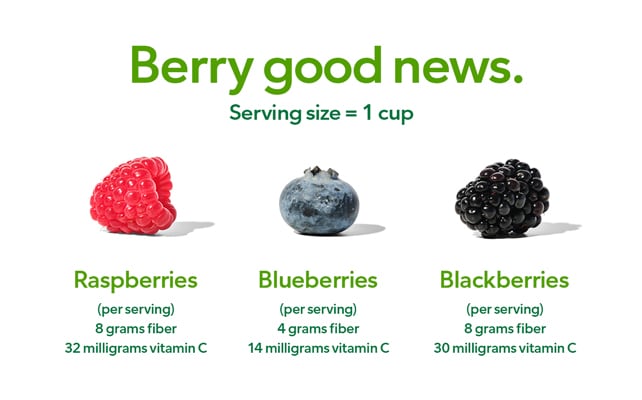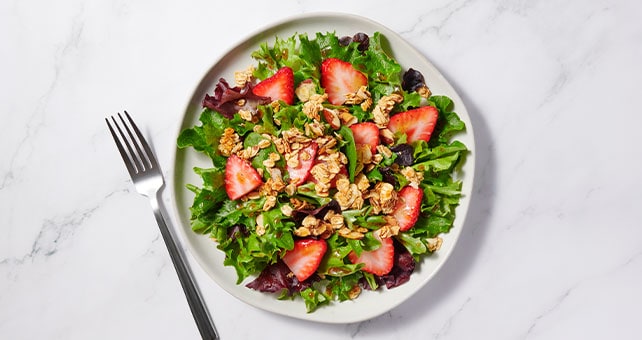Updated May 30, 2024
Summertime is ripe for finding fresh, colorful berries at Publix to include in your menu. Berries are delicious snacks and recipe ingredients, and they offer a variety of nutrients, including fiber, phytochemicals, and antioxidants like vitamin C.
We’re bursting with information about berries, such as how to store and use them in your food routine. Check out our wellness-focused recipes spanning breakfast, lunch, dinner, and even dessert! Is your mouth watering yet?
Recipes.
Little fruits. Big nutrition.
Berries are sweet, versatile, and filled with beneficial nutrients. Every 1-cup serving of blueberries1 is a good source of fiber and an excellent source of vitamin C. Blackberries and raspberries2 are also excellent sources of fiber and vitamin C.

Fiber facts.
All berries contain both soluble and insoluble fiber and can help you reach the goal of 28 grams per day, as recommended in the Dietary Guidelines for Americans, 2020–2025.8 Soluble fiber dissolves in water to form a gel-like material that may help lower blood cholesterol and glucose levels. Insoluble fiber does not dissolve in water; it may promote digestion and benefit those who struggle with constipation or irregularity.3
Bottom line:
Be sure to eat berries—and a variety of other foods that contain fiber—on a regular basis to get the fiber your body needs.
Bring on the vitamin C.
Berries provide vitamin C, another nutrient with many health benefits. Here are some reasons to include vitamin C in your diet.
Your body uses vitamin C to make collagen,4 a protein that is the main component of various connective tissues in the body. In other words, collagen is the substance that holds the body together.8 Additionally, vitamin C may increase the absorption of iron from plant-based foods and help your immune system work properly.4
Vitamin C is an antioxidant, a chemical compound that can protect cells against the effects of free radicals—molecules produced when the body breaks down food or is exposed to environmental pollutants such as tobacco smoke, air pollution, or radiation. Free radicals can damage cells and may play a role in heart, Alzheimer's, and eye diseases; cancer; and diabetes. Some studies have shown that people with low intakes of antioxidant-containing fruits and vegetables were at greater risk for developing these chronic conditions than were people who ate plenty of those foods. As a result, scientific studies have tested whether antioxidant supplements can help prevent chronic diseases, such as cardiovascular diseases, cancer, and cataracts. In most instances, antioxidant supplements did not reduce the risks of developing these diseases and in some cases, they increased the risk.5
Bottom line:
Eat a balanced diet including berries rather than supplements. Research has shown that people who eat more vegetables and fruits have lower risks of several diseases; however, it is not clear whether these results are related to the amount of antioxidants in vegetables and fruits, to other components of these foods, to other factors in people’s diets, or to other lifestyle choices.5
Colorful phytochemicals.
Berries also contain naturally occurring compounds known as phytochemicals, which are responsible for the color, flavor, and odor of plant foods. For example, berries owe their distinct hues to anthocyanin, a member of the flavonoid group of phytochemicals. Research suggests that consuming foods rich in phytochemicals may provide health benefits, including reducing the risk of diseases such as type 2 diabetes, cancer, Alzheimer’s disease, and cardiovascular disease. However, not enough information exists to make specific recommendations for phytochemical intake.6
Bottom line:
While research on the health benefits of antioxidants and phytochemicals remains inconclusive, it’s a good idea to eat fruits and vegetables as part of a balanced diet. The Dietary Guidelines for Americans, 2020–2025 associates a higher intake of fruits and vegetables as a characteristic of healthy eating patterns.7
Celebrate the season.
June is the time to find a variety of sweet, juicy berries—including organic options—in our Produce department. Follow these tips to make the most of your berries.
Eat soon after purchase or store unrinsed berries in the refrigerator. Blueberries last five to six days. Strawberries last up to three days. Blackberries and raspberries should be handled gently and refrigerated no more than two days. Rinse and drain berries right before serving, not earlier, and allow berries to come to room temperature for fullest flavor.
If you choose to freeze berries, here are some pointers:
- Do not wash berries before freezing them. Dry-pack them into containers, leaving headspace.
- You may also freeze berries first on a tray, and then pack them into containers to go back in the freezer.
- Be sure to wash your frozen berries before eating them.
- Frozen berries are great to have on hand for smoothies and recipes. If you don’t want to freeze your own, pick up some frozen organic GreenWise Whole Mixed Berries or Publix Triple Berry.
Mealtime with berries.
There are so many appetizing ways to include berries in breakfast, lunch, dinner, snacks, and even dessert. Check out our berry good meal ideas.
Berry up your breakfast.
Our Banana-Berry Oat Bake is a great choice to make ahead or serve at your next brunch.
Enjoy a quick and easy breakfast on the go with Berry PB Protein Smoothies, featuring Publix Triple Berry or GreenWise Whole Mixed Berries.
Our Crunch Waffle Sandwiches recipe is a favorite among kids of all ages.
Add sweetness to lunch or dinner.
Whole berries deliver a sweet note and a splash of color to salads, such as our Berry Salad and Oat-Almond Crumble.
Berries complement grilled or roasted beef, pork, chicken, or fish. Make your own Berry Jam from our recipe to spread on your favorite protein. Our Blueberry Chutney Turkey recipe is another tasty idea.
Better your desserts or snacks.
Dessert is done with our deliciously simple Berry Parfaits.
Satisfy snack cravings with our Anytime Smoothie Bowl.
For the love of you.
Choosing how you eat is uniquely personal. It’s about your needs, your preferences, and your goals. As your wellness ally, we’re in your corner with fresh ideas, recipes, and wellness icons that make it easier to shift toward wiser food choices. It’s all about you, at your very best.
Sources
1 Blueberries, Raw. USDA Food Composition Databases. October 28, 2022.
2 Raspberries, Raw. USDA Food Composition Databases. October 28, 2022.
3 Nutrition and Healthy Eating. Mayo Clinic. November 4, 2022.
4 Vitamin C. National Institutes of Health. March 22, 2021.
5 Antioxidant Supplements: What You Need to Know. National Center for Complementary and Integrative Health. July 2023.
6 Kumar, Ashwani, and Mukul Kumar, et al. Major Phytochemicals: Recent Advances in Health Benefits and Extraction Method. MDPI. January 16, 2023
7 U.S. Department of Agriculture & U.S. Department of Health and Human Services. Dietary Guidelines for Americans, 2020–2025, 9th ed. December 2020. Available at DietaryGuidelines.gov.
8 Collagen. Harvard T.H. Chan School of Public Health. May 2021.

 You are about to leave publix.com and enter the Instacart site that they operate and control. Publix’s delivery and curbside pickup item prices are higher than item prices in physical store locations. Prices are based on data collected in store and are subject to delays and errors. Fees, tips & taxes may apply. Subject to terms & availability. Publix Liquors orders cannot be combined with grocery delivery. Drink Responsibly. Be 21. For prescription delivery, log in to your pharmacy account by using the Publix Pharmacy app or visiting
You are about to leave publix.com and enter the Instacart site that they operate and control. Publix’s delivery and curbside pickup item prices are higher than item prices in physical store locations. Prices are based on data collected in store and are subject to delays and errors. Fees, tips & taxes may apply. Subject to terms & availability. Publix Liquors orders cannot be combined with grocery delivery. Drink Responsibly. Be 21. For prescription delivery, log in to your pharmacy account by using the Publix Pharmacy app or visiting 
